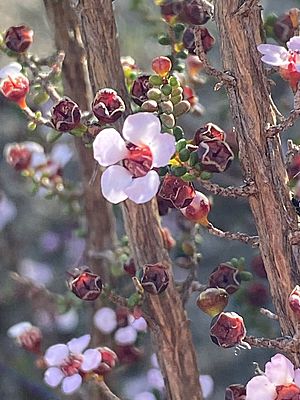Baeckea crassifolia facts for kids
Quick facts for kids Baeckea crassifolia |
|
|---|---|
 |
|
| Scientific classification | |
| Genus: |
Baeckea
|
| Species: |
crassifolia
|
The desert heath-myrtle, also called the desert baeckea, is a small shrub. Its scientific name is Baeckea crassifolia. You can often find it growing in sandy areas called heathlands. It lives along the coast in southern Australia.
Contents
What Does the Desert Heath-Myrtle Look Like?
This shrub often has many branches. It can grow straight up or spread out low to the ground. It usually reaches a height of about 0.3 to 1.3 metres (1.0 to 4.3 ft).
Leaves and Flowers
Its leaves are quite special. They are thick and juicy, like tiny succulents. They are about 5 millimetres (0.20 in) long and 1 mm (0.04 in) wide. They can be flat against the stem or stick out a little. The leaves are shaped like a narrow oval, and their tips are blunt, not pointy.
The desert heath-myrtle blooms for many months. It flowers between March and October. Its tiny flowers can be white, pink, or purple. Each flower grows alone where a leaf meets the stem. They are very small, only about 1 mm (0.04 in) across. After the flowers, the plant grows small, woody fruits. These fruits have three sections and are about 2 mm (0.08 in) wide.
Where Does the Desert Heath-Myrtle Grow?
You can find this plant in the southern parts of mainland Australia.
Australian States Where It Lives
In Western Australia, it is common in the Goldfields-Esperance region. This area is along the south coast near Esperance. It also grows further inland there. The plant likes sandy soils.
It is also found south of Alice Springs. You can even see it near Uluru, a famous landmark. In South Australia, it grows in many places east of the Eyre Peninsula. Its range extends into western Victoria and southwestern New South Wales.
How Was It Named?
The desert heath-myrtle was first officially described in 1838. A botanist named John Lindley gave it its scientific name. He included it in a book about Thomas Mitchell's travels. The book was called Three Expeditions into the interior of Eastern Australia.
Meaning of the Name
The first part of its scientific name, Baeckea, honors Abraham Baeck. He was a Swedish scientist and doctor. The second part, crassifolia, comes from Latin words. Crassus means "thick," and folium means "leaf." This name describes the plant's short, thick, and juicy leaves perfectly!

